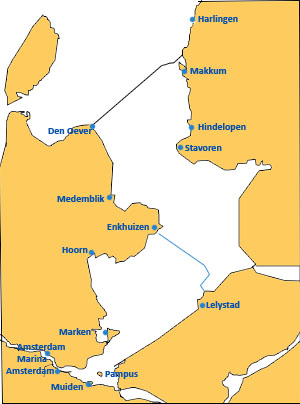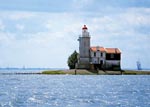
For the basis and the start of the advanced courses, we consciously choose the IJsselmeer and the Wad as a training and sailing area. Even in strong winds the courses can often continue because we have many exit possibilities to the IJsselmeer and the areas under the islands.
View the overview of basic courses with a cabin boat on the IJsselmeer and Wad.
The IJsselmeer is the largest lake in the Netherlands. From the Wadden Sea, the IJsselmeer is accessible via the Stevinssluizen and the Lorentzluizen, from Amsterdam via the Orange lock. It is a versatile practice area, shallows and channels are well laid and there are many places where you can anchor. If you control sailing on the IJsselmeer, the next step will be to the Wadden Sea and North Sea. The IJsselmeer is a beautiful waterway because of the combination of open space and historic towns where you can often moor in the old city harbor.
Makkum, Hindeloopen and Stavoren used to be fishing villages on the Zuiderzee, still clearly visible in the old centers. Hindeloopen and Stavoren belong to the Frisian Eleven Cities. The towns have an old harbor and a modern marina.
Enkhuizen and Medemblik: The image is determined by a huge fleet of recreational, cruisers and historic vessels. The towns have a large amount of monuments, historic buildings, facades and museums, of which the Zuiderzee museum is the best known. red blue green yellow
Den Oever: lies on the Afsluitdijk on the former island of Wieringen. The marina is located directly on the IJsselmeer, Wadden Sea and the North Sea, for us Den Oever is an ideal base for fresh or salt water.
 Hoorn, Marken and Muiden are located on the Markermeer. Coming from the north we first pass the Paard van Marken, the remarkable lighthouse that is visible from a great distance. They are old towns, loved by all kinds of water sports enthusiasts.
Hoorn, Marken and Muiden are located on the Markermeer. Coming from the north we first pass the Paard van Marken, the remarkable lighthouse that is visible from a great distance. They are old towns, loved by all kinds of water sports enthusiasts.
Pampus is a fortress island of more than 100 years old. It was originally intended to protect the mouth of the IJ. The fort was built on the existing shallow Pampus for which the East Indiamen had to wait before they could enter the port of Amsterdam. They were then "before Pampus". As Sea sailors, we are happy to anchor behind the island.


